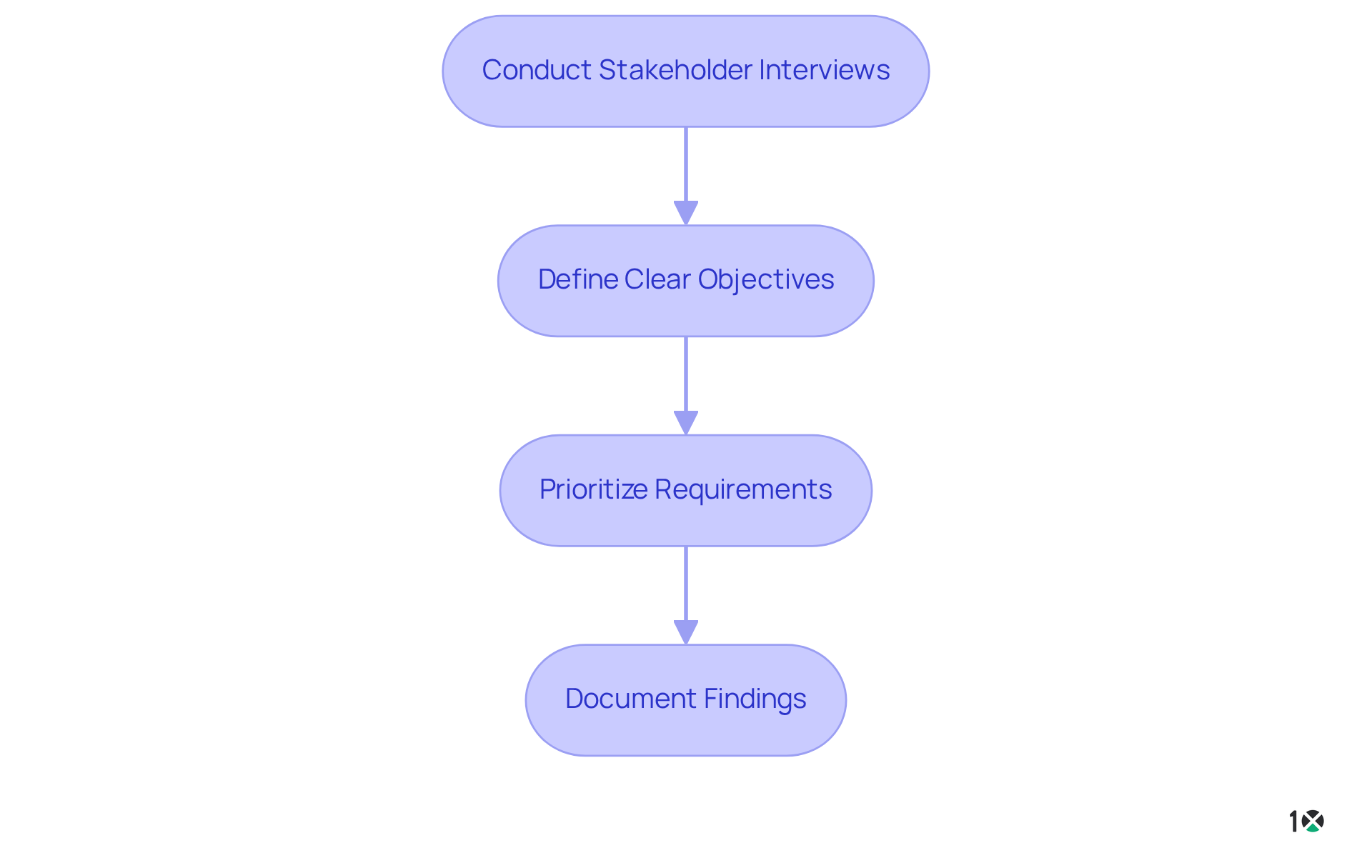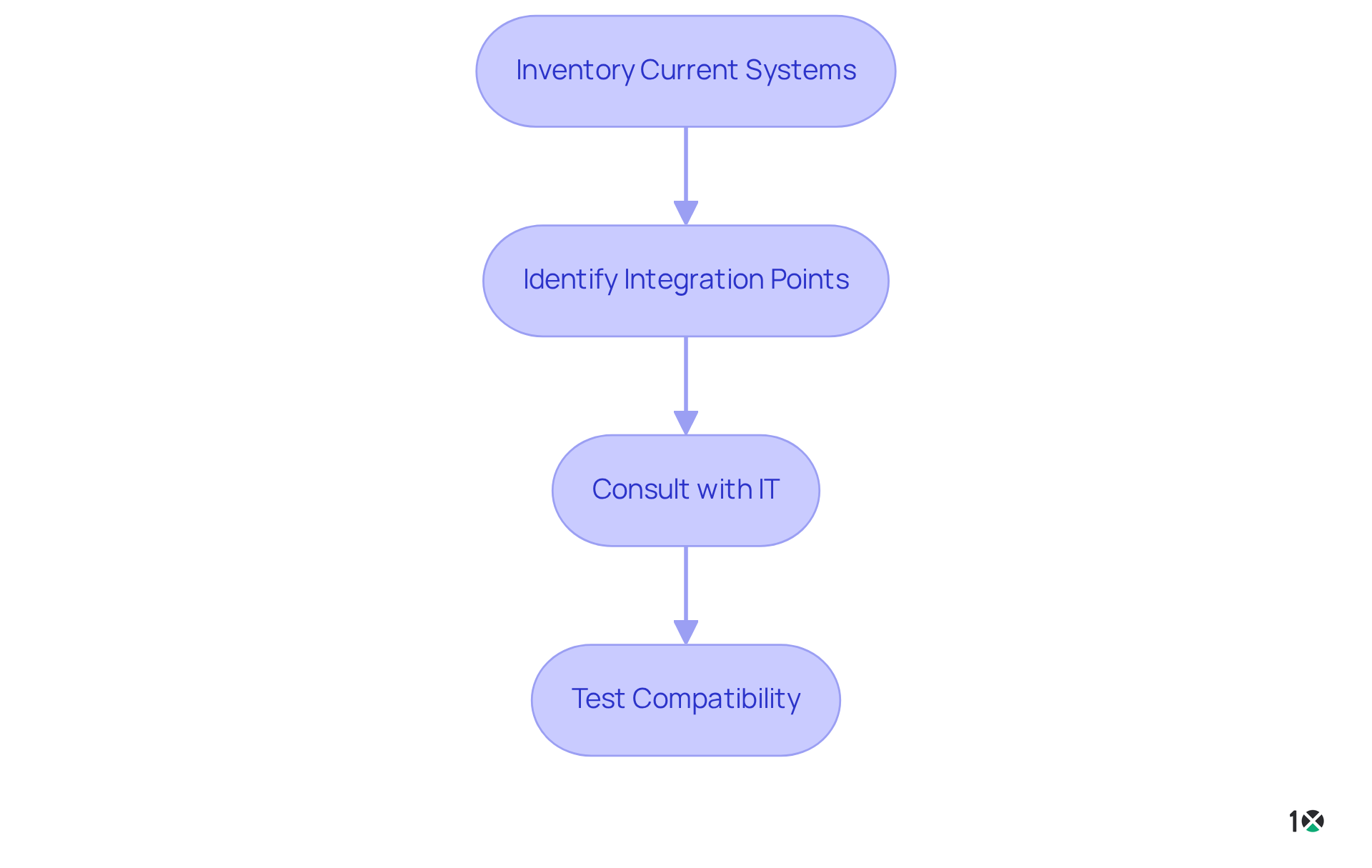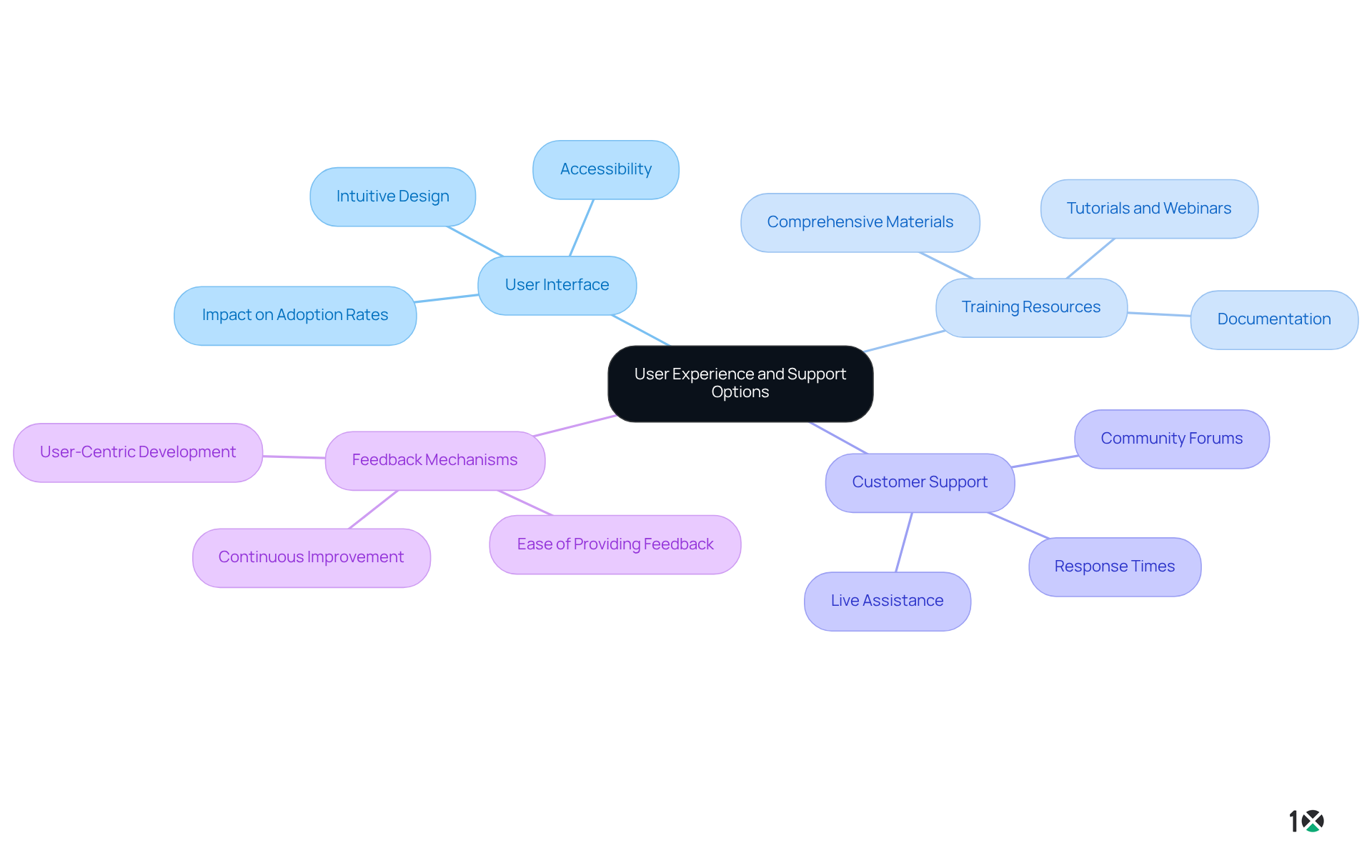Overview
To select the optimal business IT solution, organizations must adhere to a structured process. This process encompasses:
- Assessing their needs
- Evaluating available options
- Ensuring compatibility
- Considering user experience
- Ultimately making an informed decision
Each stage is critical and requires specific steps and considerations. Emphasizing the importance of stakeholder engagement and clear objectives, thorough evaluation significantly enhances the likelihood of successful implementation and alignment with overarching business goals.
Introduction
In an increasingly digital landscape, businesses encounter the formidable challenge of selecting the right IT solutions to enhance operations and drive growth. This guide presents a systematic approach to choosing an IT solution that not only addresses specific business needs but also aligns with long-term goals. Given the vast array of options available, organizations must be strategic in their decision-making to ensure they strike the right balance among efficiency, user experience, and compatibility with existing systems. How can they navigate this complex landscape to make the best choice?
Identify Your Business Needs and Goals
Begin by conducting a thorough assessment of your current operations to identify key areas where a [business IT solution](https://10xerp.com) can enhance efficiency, reduce costs, or improve customer satisfaction. Follow these steps:
- Conduct Stakeholder Interviews: Engage with team members across departments to gather insights on their challenges and requirements. This step is crucial, as 83% of senior executives cite staff adoption as their biggest challenge, underscoring the importance of inclusive discussions.
- Define Clear Objectives: Establish specific, measurable goals for the business IT solution, such as reducing processing time by 20% or improving inventory accuracy. Companies with well-defined digital transformation strategies are 1.6 times more likely to achieve revenue growth, emphasizing the significance of clear objectives.
- Prioritize Requirements: Rank your requirements based on urgency and impact to ensure that the most critical issues are addressed first. With 70% of businesses having or developing a , prioritization can significantly enhance operational efficiency.
- Document Findings: Create a comprehensive document detailing your business requirements and objectives to guide the evaluation process. This documentation will serve as a reference point, ensuring alignment with your technology goals and facilitating informed decision-making.

Evaluate Available IT Solutions
To effectively evaluate available IT solutions, begin by following these essential steps:
- Research Options: Identify software offerings tailored to your industry and operational needs. Leverage online resources, customer reviews, and relevant case studies—such as the success of 10X ERP in enhancing productivity for distributors—to inform your choices.
- Request Demos: Engage with vendors to schedule product demonstrations. Observing the software in action allows you to assess its features and user interface, which is crucial for understanding how it can meet your specific requirements.
- Compare Features: Develop a comparison chart to systematically evaluate the features of various solutions. Focus on key aspects such as functionality, scalability, and integration capabilities. Notably, research shows that businesses employing interactive demonstrations experience considerable enhancements in lead generation and conversion rates, underscoring the significance of this process.
- Check Vendor Reputation: Investigate the vendor’s history, , and user feedback. A strong reputation often correlates with reliability and effective service, which are vital for long-term partnerships.
By following these steps, you can make informed decisions that align with your business’s operational goals and enhance overall performance using a business IT solution.
Assess Compatibility with Existing Systems
Evaluating compatibility is essential for ensuring that new IT implementations integrate seamlessly with existing systems. Here’s a structured approach to effectively evaluate compatibility:
- Inventory Current Systems: Start by cataloging all existing software and hardware systems, detailing their functionalities and limitations. This comprehensive overview serves as a foundation for understanding .
- Identify Integration Points: Pinpoint where the new system will interface with current platforms, such as accounting software or inventory management tools. Recognizing these touchpoints is crucial for a smooth integration process.
- Consult with IT: Collaborate with your IT team to assess technical compatibility. Their expertise will help identify potential challenges and ensure that the new approach aligns with existing infrastructure.
- Test Compatibility: Whenever feasible, conduct a pilot test of the new approach alongside existing systems. This trial run can uncover integration issues early, allowing for adjustments before full-scale implementation.
By following these steps, businesses can navigate the complexities of ERP integration with a business IT solution, addressing common challenges such as data inconsistencies and compatibility issues that frequently arise in distribution environments.

Consider User Experience and Support Options
When evaluating potential business IT solutions, it is essential to consider aspects related to user experience and support.
- User Interface: Examine the intuitiveness of the software interface. An accessible design not only reduces training time but also greatly enhances adoption rates. Research indicates that 95% of businesses experience process improvements after implementing a business IT solution, underscoring the importance of a well-designed interface.
- Training Resources: Investigate whether the vendor offers , including tutorials, webinars, and detailed documentation. Effective training materials facilitate smoother transitions and boost confidence in utilizing the software.
- Customer Support: Evaluate the vendor’s support choices, concentrating on the accessibility of live assistance, response times, and the existence of community forums. Effective customer assistance is essential; research indicates that organizations with solid support systems experience increased software adoption rates and client satisfaction.
- Feedback Mechanisms: Seek solutions that allow individuals to provide feedback easily. This feature is crucial for ongoing software enhancement, enabling vendors to adjust their offerings according to client needs and preferences. A commitment to user feedback can significantly enhance the overall user experience, as demonstrated by 10X ERP’s focus on incorporating customer suggestions into product development.

Make an Informed Decision
After completing the earlier stages, it is essential to make a final decision. Adhere to the following guidelines:
- Review All Findings: Carefully analyze the documentation of your requirements, evaluations, and compatibility assessments to ensure all factors have been considered. This step is crucial; organizations that utilize comprehensive data in their decision-making processes are 23 times more likely to attract new customers.
- Engage Stakeholders: Actively involve key stakeholders in the decision-making process to gather diverse perspectives and secure buy-in. Effective stakeholder engagement can increase the likelihood of delivering projects on time and within budget by 40%. Engaged stakeholders provide valuable insights that significantly influence project outcomes, as evidenced by studies showing that projects with strong stakeholder plans succeed 83% of the time.
- Consider Long-term Implications: Reflect on the long-term impact of your choice, including scalability, future needs, and potential vendor changes. Organizations that prioritize stakeholder engagement are more likely to achieve project success, with 85% of such projects meeting or exceeding their goals.
- Negotiate Terms: Once you’ve selected an option, negotiate the terms of service, including pricing, support, and implementation timelines to ensure favorable conditions. This negotiation phase is vital; companies that engage stakeholders effectively see a 15% increase in employee retention and overall satisfaction, which can lead to better project outcomes.
By following these guidelines, you can make a well-informed decision that aligns with your organization’s goals and enhances the likelihood of .
Conclusion
Choosing the right business IT solution is not just a decision; it is a critical process that can significantly influence the efficiency and success of an organization. By systematically identifying business needs, evaluating available options, assessing compatibility, and considering user experience, businesses can make informed decisions that align with their operational goals and enhance overall performance.
This article outlines a comprehensive approach to selecting IT solutions, emphasizing the importance of stakeholder engagement, clear objective setting, and thorough evaluation of potential vendors and their offerings. Key steps include:
- Conducting stakeholder interviews
- Prioritizing requirements
- Checking vendor reputation
- Evaluating user support options
Each of these elements plays a vital role in ensuring that the chosen solution not only meets current needs but is also scalable for future growth.
Ultimately, the decision to implement a new IT solution should be approached with careful consideration of both immediate needs and long-term implications. Engaging stakeholders throughout the process and leveraging comprehensive data can lead to better outcomes and increased satisfaction. By following the outlined steps, organizations can navigate the complexities of IT solution selection, ensuring they choose a solution that drives success and fosters innovation in their operations.
Frequently Asked Questions
How can I identify my business needs and goals for an IT solution?
Begin by conducting a thorough assessment of your current operations, engaging with team members across departments through stakeholder interviews to gather insights on their challenges. Define clear, measurable objectives, prioritize requirements based on urgency and impact, and document your findings to guide the evaluation process.
Why are stakeholder interviews important in identifying business needs?
Stakeholder interviews are crucial because they help gather insights from team members about their challenges and requirements. This inclusivity is important, as 83% of senior executives cite staff adoption as their biggest challenge.
What should I consider when defining objectives for a business IT solution?
Establish specific, measurable goals, such as reducing processing time by 20% or improving inventory accuracy. Clear objectives are significant as companies with well-defined digital transformation strategies are 1.6 times more likely to achieve revenue growth.
How can I prioritize my requirements for an IT solution?
Rank your requirements based on urgency and impact to ensure that the most critical issues are addressed first. This prioritization can significantly enhance operational efficiency, especially as 70% of businesses have or are developing a digital transformation strategy.
What steps should I take to evaluate available IT solutions?
Start by researching options tailored to your industry, requesting demos from vendors, comparing features using a systematic comparison chart, and checking the vendor’s reputation through their history, customer support quality, and user feedback.
Why is it important to request demos from IT vendors?
Requesting demos allows you to observe the software in action, helping you assess its features and user interface, which is crucial for understanding how it can meet your specific requirements.
What should I include in a comparison chart for IT solutions?
Focus on key aspects such as functionality, scalability, and integration capabilities to systematically evaluate the features of various solutions.
How does vendor reputation affect my choice of IT solutions?
A strong vendor reputation often correlates with reliability and effective service, which are vital for establishing long-term partnerships and ensuring the success of your IT solution.
